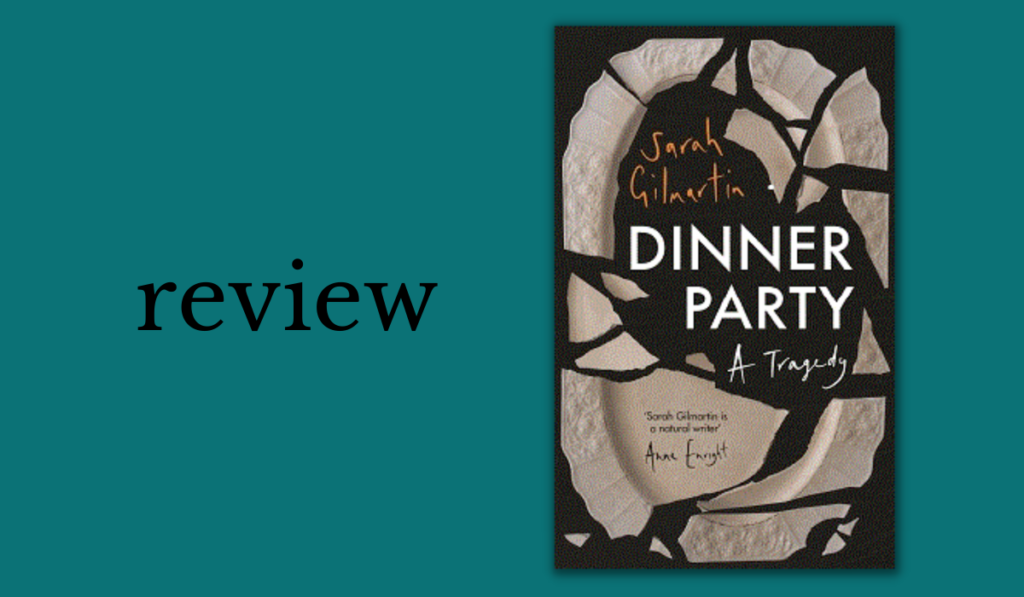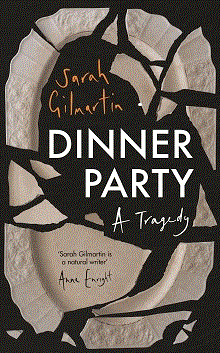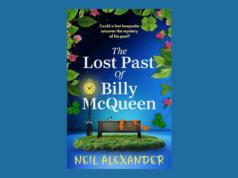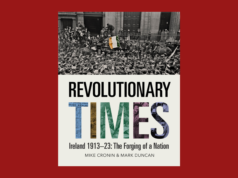
Dinner Party: A Tragedy|Sarah Gilmartin|Pushkin ONE|ISBN: 9781911590613|
“Dinner Party: A Tragedy is a strong, serious novel often leavened by warmth and good humour even as havoc and calamity lurk just beneath the surface.”
—Niall McArdle on the debut novel by Sarah Gilmartin
If you’re a twin and your twin dies, what becomes of you? Are you ever whole again? This idea is at the heart of Sarah Gilmartin’s fine debut, Dinner Party: A Tragedy.
On Halloween Kate Gleeson and her family usually mark the anniversary of Kate’s twin sister, Elaine by gathering in the family home in Carlow. Instead, Kate hosts her brothers Peter and Ray and Ray’s wife, Liz to a dinner party at her flat in Dublin, having spent all day preparing a feast. Their fierce mother, Bernadette is notably absent.
The title of the novel is a little misleading: the second half is more important than the first, but the party itself isn’t tragic, unless you count the fate of the baked Alaska. Another writer would have made the dinner party the central event of the novel, but here it happens at the start and serves to introduce characters and themes, and indeed the words ‘Dinner Party: A Tragedy’ are spoken, but only as a family in-joke among siblngs at the expense of their mother.
Eating disorder
The dinner party ends with Kate alone in her flat eating a hash brownie courtesy of Ray, which induces confusion and self-loathing as Kate, now high, verbalises the dreaded word anorexic. “She hated the word, the dramatic X, the skeletal shape of it.”
She has spent time in hospital for her eating disorder, “a time of blinding whiteness was how she remembered it now … things had been a little worse than normal, but normal was such an impossible word when it came to food.”
What follows then is Kate lying on her couch experiencing a long flashback, first reaching back to Kate’s teenaged years in the late nineties, when she and Elaine were busy dodging their mother—whose abuse of her children, physically and verbally, is one of the central elements of the story—then her college years when she tried to hide her eating disorder from her friends and flatmates.

Rural Irish family
In the flashback, Gilmartin paints a seemingly happy picture of a rural Irish family. Eldest brother Peter has returned from America and is pining for a girl in San Diego, “a place that Kate pictured exactly like Brittas Bay but with roller blades and ice-cream-cookie sandwiches.”
Ray is the family swot, getting ready for his Leaving Certificate, though he’s lazy. Their mother is horrified that he wants to do physiotherapy instead of medicine. Their father is good-humoured, kindly, and old-fashioned. “He was a laid-back man, horizontal, her mother said, but he hated cursing … he was old-fashioned in that way, more like a granddad than a dad. He was eleven and a half years older than Mammy, which was weird … he sometimes used language from another place – motorcar, homestead, gnashers – and he hated swear words above all else.”
Differences
The twins are fraternal (“identical from behind” is the family joke) so Kate is aware of their growing differences. “It was not just the breasts. Differences were starting to show up everywhere, differences and distances between them that had never been there before. Elaine no longer liked to go down to the brook at the end of the field and play jump-over. Or she would get into a huff when Kate and Ray put on The Simpsons. Or she would get jealous if Daddy brought Kate out on the farm, even though she hated farming herself…they were still best friends but they were best enemies now too.”
Trauma either brings families together or tears them apart, and Gilmartin’s main concern is how the siblings are affected not only by Elaine’s sudden death as a teenager (the scene itself comes late in the novel and clearly haunts them all as adults) but by the constant abuse from their mother.
Trauma
Early on Kate wonders why their mother is so different. “She wondered what happened to children with ordinary mothers.” Their mother is abusive: “She hadn’t been violent with them for a long time, but it was latent inside her. Kate only remembered in snapshots: a barechested Ray made to stand for the night on the landing, a pillow held over Elaine’s face … Short, barely memorable episodes that lodged like splinters in the mind”.
The mother’s abuse is rooted in her own childhood trauma: “It was something to do with her own Daddy dying so young. She was very traumatised by it still. This was a word the twins associated with their mother. A sad, grown-up word that was kind of like an apology.”
Trauma is at the core of the book. This is a damaged family, a fairly common trope in Irish literature. Eldest child Peter longs to return to California but of course ends up back on the family farm. He is the one who stays closest to Mammy. Ray becomes a doctor and has the seemingly perfect suburban life (beautiful wife, adorable twin children) but beneath it he’s miserable. Kate is a floater. She works a dead-end job as a receptionist for a boss who doesn’t appreciate her. She suffers from anorexia (which appears to stem from Elaine’s death) and has suicidal thoughts. She has an affair with a married man (which horrifies her mother).
Promise of hope
A lot of this feels … forced is the wrong word, but these are characters who seem incapable of escaping the pitfalls of adulthood. Yet at the novel’s climax, another anniversary dinner where old, long-buried resentments suddenly surface in the sort of argument that families seldom recover from, there is somehow the promise of hope, the idea that this family might actually be okay. “Really, she thought, they were all strange troubled individuals but beside each other they were clearly a family.”
Dinner Party: A Tragedy is a strong, serious novel often leavened by warmth and good humour even as havoc and calamity lurk just beneath the surface.

Niall McArdle‘s fiction has appeared in The Lonely Crowd, Spontaneity, Banshee, RTÉ Guide, and the Irish Times, and has been broadcast on RTÉ Radio











